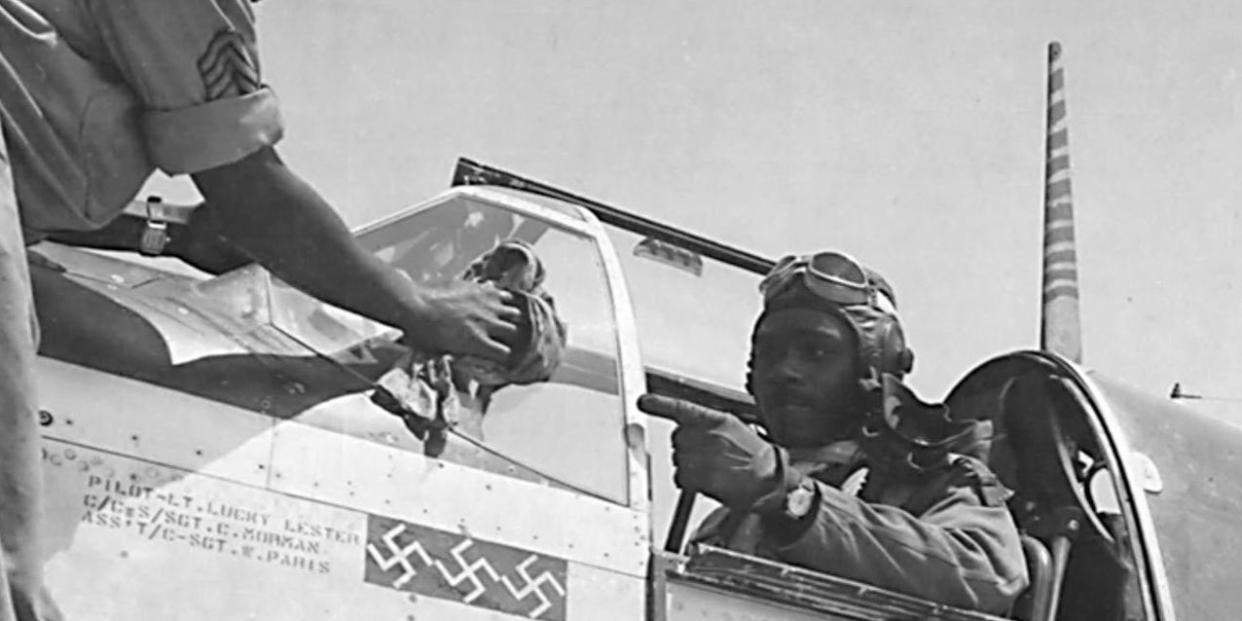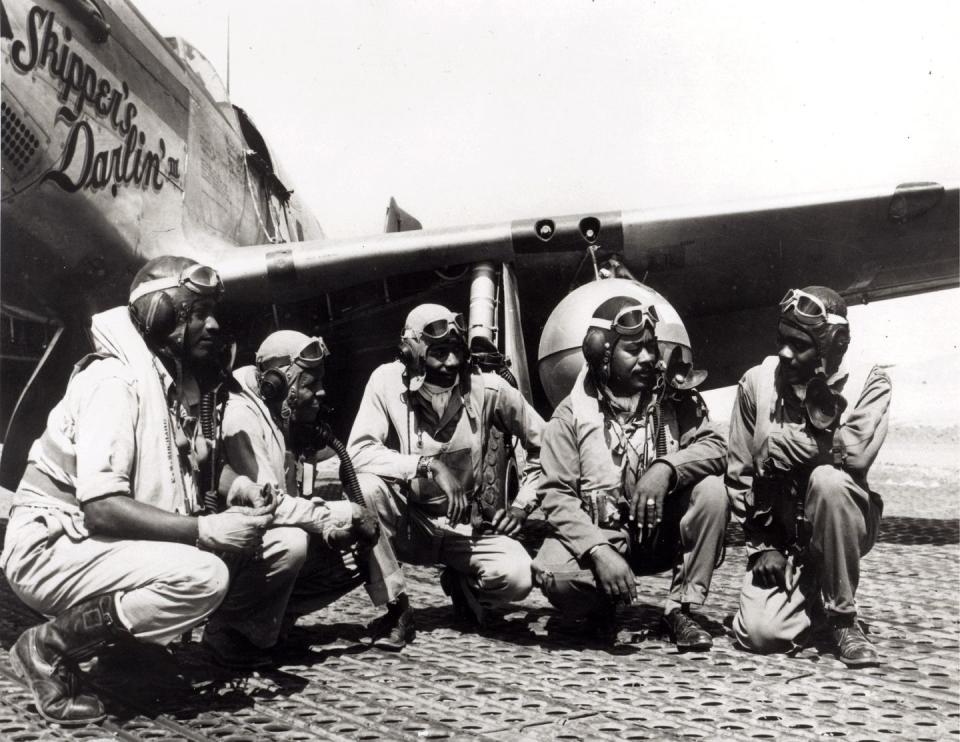This Tuskegee Airman Broke Military Barriers and Survived a Plane Ejection

"Hearst Magazines and Yahoo may earn commission or revenue on some items through these links."
During the summer of 1944, as the 15th Air Force was in the midst of a strategic bombing campaign in Nazi Germany and other areas of Europe, intelligence officials located a German airfield in Memmingen with up to 75 enemy aircraft undergoing major repair or assembly.
“This makes the airdrome one of the highest priority counter-air targets,” intelligence reports stated, according to an account by historian Daniel Haulman. A wing of B-17 bombers was assigned to attack the facility, but they were going to need some cover: Military officials predicted as many as 40 enemy fighters might be dispatched to confront the bombers.
But they were in good hands. Pilots from the famed Tuskegee Airmen, the first African American flying unit in the United States military, were assigned to provide cover during the mission on July 18, 1944. The bombers were successful, destroying 50 aircraft and three hangars at the Memmingen airfield, as well as killing 170 enemy personnel, according to Haulman.
The Tuskegee Airman had an impressive showing, too, shooting down six enemy planes during the mission. Incredibly, three of them were taken down by a single pilot: Clarence D. Lester.
“I saw a formation of Messerschmitt Bf 109s straight ahead but slightly lower. I closed to about 200 feet and started to fire,” Lester told the U.S. Air Force. “Smoke began to pour out of the 109, and the aircraft exploded. I was going so fast I was sure I would hit some of the debris from the explosion, but luckily I didn’t.”
The dramatic air battle was just one of many remarkable career accomplishments for Lester, who went by the nickname “Lucky” and was born 100 years ago this month. One of the first Black military aviators in United States history, he later worked with Defense Secretary Robert McNamara and was one of the first pilots to eject from an exploding plane.
Taking to the Skies With “Something to Prove”
Born in Richmond, Virginia, Lester was raised in Chicago and studied at Virginia State College, where he was a star football player, according to Charles E. Francis’ book The Tuskegee Airmen: The Men who Changed a Nation. In 1942, after he turned 19, he enrolled in the Army Air Force Corps and was assigned to the 100th Fighter Squadron, which was part of the 332nd Expeditionary Operations Group.
Because they trained in Tuskegee, Ala., the 332nd—along with the 477th Bombardment Group—became known as the Tuskegee Airmen. The now-famous unit flew in more than 15,000 missions in Europe and North Africa during World War II, despite serving at a time when the military was still segregated.
“Being a black pilot in the 1940s was like being a pro athlete today,” Lester told The Washington Post in 1983. “We knew we were special, that we would have to prove something. This was the first chance Blacks had had outside of working in the kitchen or the possibility of being a truck driver.”
More than Just “Lucky”

Lester completed 90 combat missions during his time with the 100th Fighter Squadron, according to Francis. Flying a P-51 Mustang he named “Miss Pelt,” Lester earned the nickname Lucky “because of all the tight situations from which I had escaped without a scratch or even a bullet hole in my aircraft,” he told the Air Force.
Lucky or not, it took incredible skill for Lester to survive so many missions. He regularly had to contend with challenges not only from enemy pilots, but also related to navigation, mechanical issues, and bad weather.
“You started out on a correct heading as you entered the clouds, but if the wind was blowing, [you] might be drifting,” Lester said, according to John Holway’s book Red Tails, Black Wings: The Men of America’s Black Air Force. “In the clouds, you had no way to check visually… you had to fly formation, guiding on your leader only, wingtips almost touching. It really took a strong heart to sit there.”
Lester continued his military service after World War II ended, serving tours in occupied Germany and Korea. And is missions during World War II weren’t the only time Lester faced mortal danger. Once, while flying 3,000 feet over Wurzburg, Germany, at 400 miles per hour, Lester’s F-84E Thunderjet exploded, according to a 1951 article in JET magazine. He ejected and escaped safely, becoming only the sixth pilot in history to use the ejection mechanism. His lucky streak had continued.
Post–World War II Career
Among his post–World War II assignments was working with the Defense Department’s “Whiz Kids,” a famous group of young experts who worked under Defense Secretary Robert McNamara on developing a modern defense strategy in the 1960s.
“They were a bunch of bright kids, all right, just out of Harvard Business School,” Lester said, according to the book Distinguished African Americans in Aviation and Space Science. “I was the ‘old man.’ I guess they needed a wiser, experienced head around to keep them on the right track.”
Lester served 28 years with the Air Force before retiring in 1969 with the rank of colonel, according to Francis. After the military, Lester joined Howard University as an associate professor of air science, according to Francis. In retirement, Lester co-founded and was the first president of the ICF International Fund, a venture capital consulting firm that seeks to help minority-owned businesses win government contracts.
Lucky’s Legacy
Lester died of cancer on March 17, 1986, at age 63 and was buried in the Arlington National Cemetery, according to Francis.
Although not a household name, Lester’s accomplishments have inspired many people over the years. Among them was Fred Cherry, a fighter pilot who spent seven years as a prisoner during the Vietnam War. It was Lester who first inspired him to join the military, according to Distinguished African Americans in Aviation and Space Science.
“When I read that Lucky Lester shot down those three Nazi planes,” Cherry said, “... I said to myself, I’m going to be a fighter pilot just as soon as I get old enough.”

